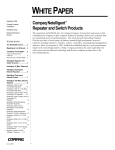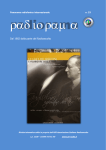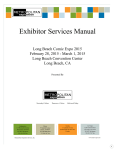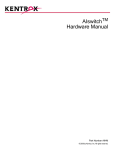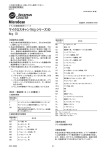Download D-Link DE-809TC User's Manual
Transcript
10BASE-T Ethernet
Mini Hubs
Models DE-809TP
DE-809TC
User’s Guide
Fifth Edition (Jan. 1999)
6DE809TP..05
Printed In Taiwan
RECYCLABLE
WARRANTIES EXCLUSIVE
,) 7+( 'ð/,1. 352'8&7 '2(6 127 23(5$7( $6 :$55$17(' $%29(ñ 7+(
&86720(5ö6 62/( 5(0('< 6+$// %(ñ $7 'ð/,1.ö6 237,21ñ 5(3$,5 25
5(3/$&(0(17ï 7+( )25(*2,1* :$55$17,(6 $1' 5(0(',(6 $5(
(;&/86,9( $1' $5( ,1 /,(8 2) $// 27+(5 :$55$17,(6ñ (;35(66(' 25
,03/,('ñ (,7+(5 ,1 )$&7 25 %< 23(5$7,21 2) /$:ñ 67$78725< 25
27+(5:,6(ñ ,1&/8',1* :$55$17,(6 2) 0(5&+$17$%,/,7< $1'
),71(66 )25 $ 3$57,&8/$5 385326(ï 'ð/,1. 1(,7+(5 $6680(6 125
$87+25,=(6 $1< 27+(5 3(5621 72 $6680( )25 ,7 $1< 27+(5
/,$%,/,7< ,1 &211(&7,21 :,7+ 7+( 6$/(ñ ,167$//$7,21 0$,17(1$1&(
25 86( 2) 'ð/,1.ö6 352'8&76ï
'ð/,1. 6+$// 127 %( /,$%/( 81'(5 7+,6 :$55$17< ,) ,76 7(67,1*
$1' (;$0,1$7,21 ',6&/26( 7+$7 7+( $//(*(' '()(&7 ,1 7+(
352'8&7 '2(6 127 (;,67 25 :$6 &$86(' %< 7+( &86720(5ö6 25 $1<
7+,5' 3(5621ö6 0,686(ñ 1(*/(&7ñ ,03523(5 ,167$//$7,21 25
7(67,1*ñ 81$87+25,=(' $77(0376 72 5(3$,5ñ 25 $1< 27+(5 &$86(
%(<21' 7+( 5$1*( 2) 7+( ,17(1'(' 86(ñ 25 %< $&&,'(17ñ ),5(ñ
/,*+71,1* 25 27+(5 +$=$5'ï
LIMITATION OF LIABILITY
,1 12 (9(17 :,// 'ð/,1. %( /,$%/( )25 $1< '$0$*(6ñ ,1&/8',1*
/266 2) '$7$ñ /266 2) 352),76ñ &267 2) &29(5 25 27+(5 ,1&,'(17$/ñ
&216(48(17,$/ 25 ,1',5(&7 '$0$*(6 $5,6,1* 287 7+(
,167$//$7,21ñ 0$,17(1$1&(ñ 86(ñ 3(5)250$1&(ñ )$,/85( 25
,17(55837,21 2) $ 'ð /,1. 352'8&7ñ +2:(9(5 &$86(' $1' 21 $1<
7+(25< 2) /,$%,/,7<ï 7+,6 /,0,7$7,21 :,// $33/< (9(1 ,) 'ð/,1. +$6
%((1 $'9,6(' 2) 7+( 3266,%,/,7< 2) 68&+ '$0$*(ï
,) <28 385&+$6(' $ 'ð/,1. 352'8&7 ,1 7+( 81,7(' 67$7(6ñ 620(
67$7(6 '2 127 $//2: 7+( /,0,7$7,21 25 (;&/86,21 2) /,$%,/,7< )25
,1&,'(17$/ 25 &216(48(17,$/ '$0$*(6ñ 62 7+( $%29( /,0,7$7,21
0$< 127 $33/< 72 <28ï
Limited Warranty
Hardware:
'ð/LQN ZDUUDQWV LWV KDUGZDUH SURGXFWV WR EH IUHH IURP GHIHFWV LQ ZRUNPDQVKLS DQG
PDWHULDOVñ XQGHU QRUPDO XVH DQG VHUYLFHñ IRU WKH IROORZLQJ SHULRGV PHDVXUHG IURP
GDWH RI SXUFKDVH IURP 'ð/LQN RU LWV $XWKRUL]HG 5HVHOOHUã
3URGXFW 7\SH
&RPSOHWH SURGXFWV
6SDUH SDUWV DQG VSDUH NLWV
ii
:DUUDQW\ 3HULRG
2QH \HDU
äí GD\V
7KH RQHð\HDU SHULRG RI ZDUUDQW\ RQ FRPSOHWH SURGXFWV DSSOLHV RQ FRQGLWLRQ WKDW WKH
SURGXFWöV 5HJLVWUDWLRQ &DUG LV ILOOHG RXW DQG UHWXUQHG WR D 'ð/LQN RIILFH ZLWKLQ QLQHW\
õäíô GD\V RI SXUFKDVHï $ OLVW RI 'ð/LQN RIILFHV LV SURYLGHG DW WKH EDFN RI WKLV PDQXDOñ
WRJHWKHU ZLWK D FRS\ RI WKH 5HJLVWUDWLRQ &DUGï )DLOLQJ VXFK WLPHO\ UHJLVWUDWLRQ RI
SXUFKDVHñ WKH ZDUUDQW\ SHULRG VKDOO EH OLPLWHG WR äí GD\Vï
,I WKH SURGXFW SURYHV GHIHFWLYH ZLWKLQ WKH DSSOLFDEOH ZDUUDQW\ SHULRGñ 'ð/LQN ZLOO
SURYLGH UHSDLU RU UHSODFHPHQW RI WKH SURGXFWï 'ð/LQN VKDOO KDYH WKH VROH GLVFUHWLRQ
ZKHWKHU WR UHSDLU RU UHSODFHñ DQG UHSODFHPHQW SURGXFW PD\ EH QHZ RU UHFRQGLWLRQHGï
5HSODFHPHQW SURGXFW VKDOO EH RI HTXLYDOHQW RU EHWWHU VSHFLILFDWLRQVñ UHODWLYH WR WKH
GHIHFWLYH SURGXFWñ EXW QHHG QRW EH LGHQWLFDOï $Q\ SURGXFW RU SDUW UHSDLUHG E\ 'ð/LQN
SXUVXDQW WR WKLV ZDUUDQW\ VKDOO KDYH D ZDUUDQW\ SHULRG RI QRW OHVV WKDQ äí GD\Vñ IURP
GDWH RI VXFK UHSDLUñ LUUHVSHFWLYH RI DQ\ HDUOLHU H[SLUDWLRQ RI RULJLQDO ZDUUDQW\ SHULRGï
:KHQ 'ð/LQN SURYLGHV UHSODFHPHQWñ WKHQ WKH GHIHFWLYH SURGXFW EHFRPHV WKH SURSHUW\
RI 'ð/LQNï
:DUUDQW\ VHUYLFH PD\ EH REWDLQHG E\ FRQWDFWLQJ D 'ð/LQN RIILFH ZLWKLQ WKH DSSOLFDEOH
ZDUUDQW\ SHULRGñ DQG UHTXHVWLQJ D 5HWXUQ 0DWHULDO $XWKRUL]DWLRQ õ50$ô QXPEHUï ,I D
5HJLVWUDWLRQ &DUG IRU WKH SURGXFW LQ TXHVWLRQ KDV QRW EHHQ UHWXUQHG WR 'ð/LQNñ WKHQ D
SURRI RI SXUFKDVH õVXFK DV D FRS\ RI WKH GDWHG SXUFKDVH LQYRLFHô PXVW EH SURYLGHGï ,I
3XUFKDVHUöV FLUFXPVWDQFHV UHTXLUH VSHFLDO KDQGOLQJ RI ZDUUDQW\ FRUUHFWLRQñ WKHQ DW
WKH WLPH RI UHTXHVWLQJ 50$ QXPEHUñ 3XUFKDVHU PD\ DOVR SURSRVH VSHFLDO SURFHGXUH DV
PD\ EH VXLWDEOH WR WKH FDVHï
$IWHU DQ 50$ QXPEHU LV LVVXHGñ WKH GHIHFWLYH SURGXFW PXVW EH SDFNDJHG VHFXUHO\ LQ
WKH RULJLQDO RU RWKHU VXLWDEOH VKLSSLQJ SDFNDJH WR HQVXUH WKDW LW ZLOO QRW EH GDPDJHG
LQ WUDQVLWñ DQG WKH 50$ QXPEHU PXVW EH SURPLQHQWO\ PDUNHG RQ WKH RXWVLGH RI WKH
SDFNDJHï 7KH SDFNDJH PXVW EH PDLOHG RU RWKHUZLVH VKLSSHG WR 'ð/LQN ZLWK DOO FRVWV RI
PDLOLQJîVKLSSLQJîLQVXUDQFH SUHSDLGâ 'ð/LQN ZLOO RUGLQDULO\ UHLPEXUVH 3XUFKDVHU IRU
PDLOLQJîVKLSSLQJîLQVXUDQFH H[SHQVHV LQFXUUHG IRU UHWXUQ RI GHIHFWLYH SURGXFW LQ
DFFRUGDQFH ZLWK WKLV ZDUUDQW\ï 'ð/LQN VKDOO QHYHU EH UHVSRQVLEOH IRU DQ\ VRIWZDUHñ
ILUPZDUHñ LQIRUPDWLRQñ RU PHPRU\ GDWD RI 3XUFKDVHU FRQWDLQHG LQñ VWRUHG RQñ RU
LQWHJUDWHG ZLWK DQ\ SURGXFW UHWXUQHG WR 'ð/LQN SXUVXDQW WR WKLV ZDUUDQW\ï
$Q\ SDFNDJH UHWXUQHG WR 'ð/LQN ZLWKRXW DQ 50$ QXPEHU ZLOO EH UHMHFWHG DQG
VKLSSHG EDFN WR 3XUFKDVHU DW 3XUFKDVHUöV H[SHQVHñ DQG 'ð/LQN UHVHUYHV WKH ULJKW LQ
VXFK D FDVH WR OHY\ D UHDVRQDEOH KDQGOLQJ FKDUJH LQ DGGLWLRQ PDLOLQJ RU VKLSSLQJ FRVWVï
D-Link Offices for Registration and Warranty
Service
7KH SURGXFWöV 5HJLVWUDWLRQ &DUGñ SURYLGHG DW WKH EDFN RI WKLV PDQXDOñ PXVW EH VHQW WR
D 'ð/LQN RIILFHï 7R REWDLQ DQ 50$ QXPEHU IRU ZDUUDQW\ VHUYLFH DV WR D KDUGZDUH
SURGXFWñ RU WR REWDLQ ZDUUDQW\ VHUYLFH DV WR D VRIWZDUH SURGXFWñ FRQWDFW WKH 'ð/LQN
RIILFH QHDUHVW \RXï $Q DGGUHVVHVîWHOHSKRQHîID[ OLVW RI 'ð/LQN RIILFHV LV SURYLGHG LQ WKH
EDFN RI WKLV PDQXDOï
iii
iv
Trademarks
&RS\ULJKW ìäää 'ð/LQN &RUSRUDWLRQï
&RQWHQWV VXEMHFW WR FKDQJH ZLWKRXW SULRU QRWLFHï
'ð/LQN LV D UHJLVWHUHG WUDGHPDUN RI 'ð/LQN &RUSRUDWLRQî'ð
/LQN 6\VWHPVñ ,QFï
$OO RWKHU WUDGHPDUNV EHORQJ WR WKHLU UHVSHFWLYH SURSULHWRUVï
Copyright Statement
1R SDUW RI WKLV SXEOLFDWLRQ PD\ EH UHSURGXFHG LQ DQ\ IRUP
RU E\ DQ\ PHDQV RU XVHG WR PDNH DQ\ GHULYDWLYH VXFK DV
WUDQVODWLRQñ WUDQVIRUPDWLRQñ RU DGDSWDWLRQ ZLWKRXW
SHUPLVVLRQ IURP 'ð/LQN &RUSRUDWLRQî'ð/LQN 6\VWHPV ,QFïñ
DV VWLSXODWHG E\ WKH 8QLWHG 6WDWHV &RS\ULJKW $FW RI ìäæçï
FCC Warning
Class A for Model DE-809TP
7KLV HTXLSPHQW KDV EHHQ WHVWHG DQG IRXQG WR FRPSO\ ZLWK
WKH OLPLWV IRU D &ODVV $ GLJLWDO GHYLFHñ SXUVXDQW WR 3DUW ìè
RI WKH )&& 5XOHVï 7KHVH OLPLWV DUH GHVLJQHG WR SURYLGH
UHDVRQDEOH SURWHFWLRQ DJDLQVW KDUPIXO LQWHUIHUHQFH ZKHQ
WKH HTXLSPHQW LV RSHUDWHG LQ D FRPPHUFLDO HQYLURQPHQWï
7KLV HTXLSPHQW JHQHUDWHVñ XVHVñ DQG FDQ UDGLDWH UDGLR
IUHTXHQF\ HQHUJ\ DQGñ LI QRW LQVWDOOHG DQG XVHG LQ
DFFRUGDQFH ZLWK WKLV XVHUªV JXLGHñ PD\ FDXVH KDUPIXO
LQWHUIHUHQFH WR UDGLR FRPPXQLFDWLRQVï 2SHUDWLRQ RI WKLV
HTXLSPHQW LQ D UHVLGHQWLDO DUHD LV OLNHO\ WR FDXVH KDUPIXO
LQWHUIHUHQFH LQ ZKLFK FDVH WKH XVHU ZLOO EH UHTXLUHG WR
FRUUHFW WKH LQWHUIHUHQFH DW KLV RZQ H[SHQVHï
v
Class B for Model DE-809TC
FCC ID No: KA2HPC09TC1
7KLV HTXLSPHQW KDV EHHQ WHVWHG DQG IRXQG WR FRPSO\ ZLWK
WKH OLPLWV IRU D &ODVV % GLJLWDO GHYLFHñ SXUVXDQW WR 3DUW ìè
RI WKH )&& 5XOHVï 7KHVH OLPLWV DUH GHVLJQHG WR SURYLGH
UHDVRQDEOH SURWHFWLRQ DJDLQVW KDUPIXO LQWHUIHUHQFH LQ D
UHVLGHQWLDO LQVWDOODWLRQï 7KLV HTXLSPHQW JHQHUDWHVñ XVHVñ
DQG FDQ UDGLDWH UDGLR IUHTXHQF\ HQHUJ\ DQGñ LI QRW LQVWDOOHG
DQG XVHG LQ DFFRUGDQFH ZLWK WKLV XVHUªV JXLGHñ PD\ FDXVH
KDUPIXO LQWHUIHUHQFH WR UDGLR FRPPXQLFDWLRQVï +RZHYHUñ
WKHUH LV QR JXDUDQWHH WKDW LQWHUIHUHQFH ZLOO QRW RFFXU LQ D
SDUWLFXODU LQVWDOODWLRQï
,I WKLV HTXLSPHQW GRHV FDXVH
KDUPIXO LQWHUIHUHQFH WR UDGLR RU WHOHYLVLRQ UHFHSWLRQñ ZKLFK
FDQ EH GHWHUPLQHG E\ WXUQLQJ WKH HTXLSPHQW RII DQG RQñ WKH
XVHU LV HQFRXUDJHG WR WU\ WR FRUUHFW WKH LQWHUIHUHQFH E\ RQH
RU PRUH RI WKH IROORZLQJ PHDVXUHVã
♦
5HRULHQW RU UHORFDWH WKH UHFHLYLQJ DQWHQQDï
♦
,QFUHDVH WKH VHSDUDWLRQ EHWZHHQ WKH HTXLSPHQW DQG
UHFHLYHUï
♦
&RQQHFW WKH HTXLSPHQW LQWR DQ RXWOHW RQ D FLUFXLW
GLIIHUHQW IURP WKDW WR ZKLFK WKH UHFHLYHU LV FRQQHFWHGï
♦
&RQVXOW WKH GHDOHU RU DQ H[SHULHQFHG UDGLRî79
WHFKQLFLDQ IRU KHOSï
6KLHOGHG LQWHUIDFH FDEOHV PXVW EH XVHG LQ RUGHU WR FRPSO\
ZLWK HPLVVLRQ OLPLWVï
&KDQJHV RU PRGLILFDWLRQV QRW H[SUHVVO\ DSSURYHG E\ XVHUªV
DXWKRULW\ WR RSHUDWH WKLV HTXLSPHQWï
vi
9&&, , :DUQLQJ )RU 0RGHO '(ðåíä73
VCCI II Warning For Model DE-809TC
vii
8
Table of Contents
1 INTRODUCTION...................................................................... 1
2 INSTALLATION ....................................................................... 5
MOUNTING HUB ON WALL ........................................................... 5
CONNECTING AC POWER ADAPTER .............................................. 7
CONNECTING UTP SEGMENTS ...................................................... 8
CONNECTING THIN COAXIAL SEGMENT....................................... 10
CASCADING HUBS THROUGH THIN COAXIAL CABLE .................... 11
CASCADING HUBS THROUGH UTP CABLE ................................... 12
DIAGNOSTIC LEDS & TROUBLESHOOTING .................................. 14
A CABLES, CONNECTORS & AC POWER ADAPTERS ......... 17
10BASE-T UNSHIELDED TWISTED-PAIR (UTP) CABLE ............... 17
10BASE2 THIN COAXIAL CABLE ............................................... 17
AC POWER ADAPTERS ............................................................... 18
B TECHNICAL SPECIFICATIONS .......................................... 20
10BASE-T Ethernet Mini Hubs User’s Guide
1
Introduction
This User’s Guide tells you how to install the following 10BASE-T
Ethernet Mini Hub models:
♦
♦
DE-809TP (9 UTP ports)
DE-809TC (8 UTP ports & 1 BNC port)
Port connectors on back panel of Mini Hubs
Introduction
1
The Mini Hubs are the palm-size compact 10BASE-T hubs that
offer all the features of standard equipment rack-mount 10BASE-T
hubs, including automatic port participation, collision detection,
diagnostic LED report, and hub cascading.
Following is a summary of the features of the Mini Hubs:
♦
9-port hubs. Each Mini Hub provides nine ports. Model DE809TP provides nine UTP ports (nine RJ-45 connectors); one of
these ports can be used for either 10BASE-T connection or
cascading with another Mini Hub. Model DE-809TC provides
eight UTP ports (eight RJ-45 connectors) and one BNC port.
♦
Cascading. Through an “Uplink” switch, a UTP port of the
DE-809TP can be used for cascading with another Mini Hub.
The DE-809TC provides a BNC port for cascading with other
hubs without sacrificing any UTP port.
♦
Backbone connection. The BNC port on the DE-809TC also
allows the portable Mini Hub to be attached to a coaxial
backbone to be part of a larger network.
♦
Installation flexibility. The Mini Hub is ideal for a small-size
network with nine or fewer nodes. Its cascading port however
permits the network to expand to 32 ports or more.
♦
Compact, lightweight. The Mini Hub’s small size makes it
easy to install even at installation sites with tight space. It takes
little space on a desktop, and its light weight allows it to be
easily mounted on a wall.
2
Introduction
10BASE-T Ethernet Mini Hubs User’s Guide
Introduction
3
10BASE-T Ethernet Mini Hubs User’s Guide
2
Installation
Mounting Hub on Wall
The Mini Hub can be mounted on a wall. Four mounting slots are
provided on the bottom side of the hub for this purpose. Make sure
that the front panel is exposed to allow you to view the LEDs at
work.
Installation
5
Distance: 155.6 mm / 6.13 in. (top diagram)
Distance: 70.5 mm/2.74 in. (bottom diagram)
6
Installation
10BASE-T Ethernet Mini Hubs User’s Guide
Connecting AC Power Adapter
The Mini Hub uses an external AC power adapter. There is no
power switch. The hub is powered on once the AC power adapter is
connected to an AC power source and the hub’s AC power socket.
&DXWLRQã
7R SUHYHQW GDPDJH WR \RXU KXEñ EHIRUH \RX
EHJLQ XVLQJ WKH $& SRZHU DGDSWHUñ GRXEOHð
FKHFN LWV LQSXW $& YROWDJHï 7KH $& SRZHU
DGDSWHUªV LQSXW YROWDJH PXVW FRQIRUP WR LWV
$& SRZHU VRXUFHªV YROWDJHï $SSHQGL[ $ OLVWV
WKH VSHFLILFDWLRQV RI WKH $& SRZHU DGDSWHUV
DSSOLFDEOH WR 0LQL +XEV DQG WR GLIIHUHQW
FRXQWULHVï
,I \RX XVH DQ $& SRZHU DGDSWHU VXSSOLHG E\
\RXUVHOIñ DQG \RXU FRXQWU\ LV QRW OLVWHG LQ
WKH DSSHQGL[ñ FKHFN ZLWK \RXU QHWZRUNLQJ
SURGXFWV GHDOHU WR PDNH VXUH WKDW \RX XVH D
SURSHU $& SRZHU DGDSWHUï
Installation
7
&DXWLRQã 8VH $& SRZHU DGDSWHU ZLWK FRUUHFW $&
YROWDJH RQO\ï
Connecting UTP Segments
This section describes the connection procedure from a UTP port of
the hub to a UTP port of a station, bridge , router, and other
Ethernet devices. It does not describe the connection to a 10BASET hub. The UTP cable extended from a UTP port is called a UTP
segment, and can be up to 100 meters long.
8
Installation
10BASE-T Ethernet Mini Hubs User’s Guide
Note that, for Mini Hub model DE-809TP, UTP port labeled “9”
must be in the Normal position in order to be connectable to a
station, bridge or router. To connect this port to a UTP port of a
10BASE-T hub, the port must be in the Uplink position (see section
Cascading Hubs Through UTP Cable in this chapter for details).
The button to the right of the UTP port labeled “9” is used to switch
between the Normal and the Uplink position.
Installation
9
Connecting Thin Coaxial Segment
The BNC port on Mini Hub model DE-809TC is used to connect to
a thin coaxial segment. Connect a T-connector to the BNC
connector, then connect both ends of the T-connector to the thin
coaxial cable. If the thin coaxial segment terminates at the hub,
attach a 50-ohm terminator to one end of the T-connector.
10
Installation
10BASE-T Ethernet Mini Hubs User’s Guide
Cascading Hubs Through Thin
Coaxial Cable
The BNC port on the Mini Hub model DE-809TC can be used to
cascade hubs together. You may cascade DE-809TC hubs together
through the BNC ports. You may also cascade the DE-809TC with
any other IEEE 802.3 Ethernet standard 10BASE-T hubs equipped
with BNC ports.
You may attach up to thirty nodes to a thin coaxial segment. In this
sense, it is possible to cascade a maximum of thirty hubs together
through the thin coaxial cable.
Be sure to leave a minimum of 0.5 meter (2 feet) of cable between
two BNC ports.
Installation
11
Cascading Hubs Through UTP
Cable
Any of the UTP ports can be used to cascade hubs together. Note
that when two UTP ports of two hubs are connected together, the
wires inside the UTP cable must be crossed over. See appendix A
for the wire cross-over. Mark all crossed-over UTP cables clearly so
they will not be used by mistake for normal connection.
If you use Mini Hub model DE-809TP, UTP port labeled “9” is
especially designed for hub cascading. When this port is in the
Uplink position, its signal reception and transmission are reversed.
This allows you to dispense with the trouble of crossing the UTP
cable’s wires. Putting this port in the Uplink position can be done
by pressing down the button located next to the port.
Note: Never cause a loop when you cascade hubs since this might
cause unpredictable results.
12
Installation
10BASE-T Ethernet Mini Hubs User’s Guide
Hub cascading: If straight-through UTP cable is
used, one UTP port must be in Uplink position.
Installation
13
Diagnostic LEDs & Troubleshooting
♦
Power.
◊ ON: “power good”.
◊ OFF: “power bad.” Check to see if the AC power adapter
is properly connected, or if the correct AC power adapter is
being used.
DE-809TP
14
Installation
10BASE-T Ethernet Mini Hubs User’s Guide
DE-809TC
Diagnostic LEDs on front panel of Mini Hubs
♦
Collision.
◊ Blinking: Packet collision is occurring. Packet collisions
are not an abnormal situation. Collisions occur when two
or more computers transmit packets on the network
simultaneously, and a contention takes place on the
network line. The computers should then back off, then
retry transmission. This trial-and-error process is repeated
until no collision takes place. Note: Excessive collisions
may result when multiple hubs are cascaded through a thin
coaxial segment and many stations are connected on the
network.
◊ Off: No packet collision.
♦
Link/Rx (for each UTP port).
◊ ON: Data link between (1) Mini Hub’s UTP port and (2)
node’s or cascaded hub’s UTP port is successful.
◊ OFF: (1) No data link or (2) cable disconnected. Check
for bad cable or loose connectors. For cascaded hubs, check
to see if UTP cable contains crossed-over wires. Also check
for a “power good” condition at both ends of the
connection. If you suspect that the hub port is damaged,
contact your authorized dealer for service.
◊ Blinking: Packet reception is occurring.
Installation
15
♦
Rx (for BNC port).
◊ Blinking: Packet reception is occurring.
◊ OFF: No packet reception.
♦
Partition (for each UTP port).
◊ ON: The UTP port is being partitioned off due to excessive
packet collisions. Note that the UTP cable between a hub
port and a non-repeater node must contain straight-through
wires (no cross-over).
◊ OFF: Segment has no problem.
♦
Partition (for BNC port).
◊ ON: The BNC port is being partitioned off due to (1) no
cable is connected, (2) faulty cable or connectors, (3)
excessive packet collisions, (4) a disconnected point
somewhere along the entire thin coaxial cable length, or (5)
unterminated segment. Check all connectors along the
cable length. If segment is not terminated, terminate both
ends with 50-ohm terminators.
◊ OFF: (1) Cable is connected and (2) segment has no
problem.
♦
Uplink
◊ ON: The “9” UTP port is in the Uplink position (crosswired).
◊ OFF: The “9” UTP port is in the Normal position
(straight-through wires).
16
Installation
10BASE-T Ethernet Mini Hubs User’s Guide
A
Cables, Connectors &
AC Power Adapters
10BASE-T Unshielded Twisted-Pair
(UTP) Cable
♦
♦
♦
Cable characteristics: 0.4 - 0.6 mm (22 - 26 AWG) 8-wire
(only 4 wires used for 10BASE-T)
Maximum segment length: 100 meters
Applicable connectors: RJ-45, Telco-50
10BASE2 Thin Coaxial Cable
♦
♦
♦
♦
Cable characteristics: 0.2 inch diameter RG-58A/U 50 ohm
Maximum segment length: 185 meters
Minimum distance between two nodes: 0.5 meter
Maximum number of nodes per segment: 30
Cables, Connectors & AC Power Adapters
17
AC Power Adapters
The following lists the specifications of the AC power adapters
supplied by D-Link for use with the Mini Hub. Your Mini Hub
package may contain one of these AC power adapters. If you use an
AC power adapter supplied by yourself, make sure that it complies
with the output power listed below and the input power and plug
(AC power specifications) of your area.
AC power adapter model AD-071A
⇒ Input power: AC 120 volts, 50-60Hz
⇒ Output power: DC 7.5 volts unregulated, 1 A
⇒ Maximum power consumption: 7.5 watts
⇒ Plug: North American standards
⇒ Safety standards: UL/CSA
AC power adapter model AD-071AD
⇒ Input power: AC 240 volts, 50-60Hz
⇒ Output power: DC 7.5 volts unregulated, 1 A
⇒ Maximum power consumption: 7.5 watts
⇒ Plug: U.K. standard
⇒ Safety standard: BSI
AC power adapter model AD-071AB
⇒ Input power: AC 220 volts, 50-60Hz
⇒ Output power: DC 7.5 volts unregulated, 1 A
⇒ Maximum power consumption: 7.5 watts
18
Cables, Connectors & AC Power Adapters
10BASE-T Ethernet Mini Hubs User’s Guide
⇒ Plug: German standard
⇒ Safety standard: VDE
AC Power adapter model AD-071AJ
⇒ Input power: AC 100 volts, 50-60Hz
⇒ Output power: DC 7.5 volts unregulated, 1 A
⇒ Maximum power consumption: 7.5 watts
⇒ Safety standard: Japan T-mark
Cables, Connectors & AC Power Adapters
19
B
Technical
Specifications
DE-809TP
♦
♦
♦
♦
♦
♦
♦
♦
♦
♦
♦
♦
♦
♦
20
Standard: IEEE 802.3 10BASE-T.
Medium support: UTP.
Number of UTP ports: 9.
Number of connectors: 9 RJ-45.
Cascading: Switchable straight-through/cross-wired UTP port
(“uplink”) button
Number of diagnostic LEDs: 21
Power requirement: DC 7.5 volts 1 Amp.
Power feeding: through AC power adapter.
Operating temperature: -10° to 55° Celsius.
Humidity: 5% - 95% non-condensing.
Dimensions: 197 x 115 x 28 mm (7.75 x 4.53 x 1.10 inches)
Weight: 300 ±10 grams (AC power adapter excluded)
Safety: UL/CSA.
EMI: FCC-B, CE-B, VCCI-A, C-Tick, BCIQ
Technical Specifications
10BASE-T Ethernet Mini Hubs User’s Guide
DE-809TC
♦
♦
♦
♦
♦
♦
♦
♦
♦
♦
♦
♦
♦
♦
Standard: IEEE 802.3 10BASE-T.
Medium support: thin coaxial, UTP.
Number of UTP ports: 8.
Number of BNC ports: 1.
Number of connectors: 8 RJ-45, 1 BNC.
Number of diagnostic LEDs: 20
Power requirement: DC 7.5 volts 1 Amp.
Power feeding: through AC power adapter.
Operating temperature: -10° to 55° Celsius.
Humidity: 5% - 95% non-condensing.
Dimensions: 197 x 115 x 28 mm (7.75 x 4.53 x 1.10 inches)
Weight: 350 ±10 grams (AC power adapter excluded)
Safety: UL/CSA.
EMI: FCC-B, CE-B, VCCI-B, C-Tick, BCIQ
Technical Specifications
21
22
Cables, Connectors & AC Power Adapters
Offices
8ï6ï$ï
'ð/,1. 6<67(06ñ ,1&ï
&$1$'$
'ð/,1. &$1$'$ñ ,1&ï
'(10$5.
'ð/,1. '(10$5.
)5$1&(
'ð/,1. )5$1&(
*(50$1<
'ð/,1. õ'(876&+/$1'ô *0%+ ,ï*ï
,7$/<
'ð/,1. ,7$/<
6:('(1
'ð/,1. $î%
8ï.ï
LQIR#GOLQNïFRïXN
èê 'LVFRYHU\ 'ULYHñ ,UYLQHñ &$ äëçìå 86$
7(/ã ìðäéäðæååðíåíè )$;ã ìðäéäðæèêðæíêê :(%ã ZZZïGOLQNïFRP
(ð0$,/ã WHFK#GOLQNïFRP
úëìåí :LQVWRQ 3DUN 'ULYHñ 2DNYLOOHñ 2QWDULRñ /ç+ è:,ñ &DQDGD
7(/ã ìðäíèðåëäðèíêê )$;ã ìðäíèðåëäðèëëê :(%ã ZZZïGOLQNïFD
)73ã IWSïGOLQNQHWïFRP (ð0$,/ã VXSSRUW#GOLQNïFD (ð0$,/ã VDOHV#GOLQNïFD
1DYHUODQG ë '.ðëçíí *ORVWUXS &RSHQKDJHQñ 'HQPDUN
7(/ãéèðéêðäçäðíéí )$;ãéèðéêðéëéðêéæ
/H )/25,/(*( úëñ $OOHH GH OD )UHVQHULH
æåêêí )RQWHQD\ /H )OHXU\ )UDQFH
7(/ã êêðìðêíëêðåçåå )$;ã êêðìðêíëêðåçåä :(%ã ZZZïGOLQNðIUDQFHïFRP
%DFKVWUDH ëëñ çèåêí .ULIWHO *HUPDQ\
7(/ã éäðçìäëðäæììí )$;ã éäðçìäëðäæìììì :(%ã ZZZïGOLQNïGH %%6ã éäðçìäëðäæììää
,1)2ã íìêíðæëèíðíí õWROO IUHHô +(/3ã íìêíðæëèíðéí õWROO IUHHô
9LD 1LQR %RQQHW Qï çñ ëíìèé 0LODQRñ ,WDO\
7(/ã êäðëðëäííðíçæç )$;ã êäðëðëäííðìæëê
:RUOG 7UDGH &HQWHU 3ï 2ï %R[ æíêäçñ ìíæ ëé 6WRFNKROP 6ZHGHQ
7(/ã éçðåðæííðçëìì )$;ã éçðåðëìäðçéí (ð0$,/ã LQIR#GOLQNïVH
'ð/,1. õ(8523(ô /7'ï
'ð/LQN +RXVHñ ç *DUODQG 5RDGñ 0LGGOHVH[ +$æ ì'3 8ï.ï
7(/ã ééðìåìðëêèðèèèè )$;ã ééðìåìðëêèðèèíí :(%ã ZZZïGOLQNïFRPïXN
(*<37
'ð/,1. 0,''/( ($67
$8675$/,$
'ð/,1. $8675$/,$ 37<ï/7'ï
(ð0$,/ã
æ $VVHP %HQ 6DEHW 6WUHHWñ +HOLRSROLVñ &DLURñ (J\SW
7(/ã ëíëðëéèðçìæç )$;ã ëíëðëéèðçìäë :(%ã ZZZïGOLQNðPHïFRP
ZZZïGOLQNïFRPïDX (ð
8QLW ìçñ êäí (DVWHUQ 9DOOH\ :D\ 5RVHYLOOHñ 16: ëíçä $XVWUDOLD
7(/ã çìðëðäéìæðæìíí
)$;ã çìðëðäéìæðìíææ
72// )5((ã
0$,/ã LQIR#GOLQNïFRPïDX
&+,1$
'ð/,1. %(,-,1*
,1',$
'ð/,1. õ,1',$ô 397ï /7'ï
-$3$1
'ð/,1. 72.<2
6,1*$325(
'ð/,1. 6,1*$325( 37(ï/7'ï
7$,:$1
'ð/,1. 7$,:$1
ìðåííìææìí
ìèWK )ORRUñ 6FLHQFH ÷ 7HFKQRORJ\ 7RZHUñ
1Rï ììñ %DLVKLTLDR 5RDGñ +DLGLDQ 'LVWULFWñ %HLMLQJ ìíííåì &KLQD
7(/ã åçðìíðçåéçæìíçðä )$;ã åçðìíðçåéçæììí :(%ã ZZZïGOLQNïFRïFQ
%RPED\ 2IILFH ã 3ORW 1Rïèñ .XUODð%DQGUD &RPSOH[ 5Gï
2II &VW 5Gïñ 6DQWDFUX] õ(ô %RPED\ ð éíí íäå ,QGLD
7(/ã äìðëëðçìæëéæå )$;ã äìðëëðçìæëéæç
ìí)ñ åðåðìè 1LVKLJRWDQGDñ 6KLQDJDZDðNX 7RN\R ìéì -DSDQ
7(/ã åìðêðèéêéðäçæå )$;ã åìðêðèéêéðäåçå :(%ã ZZZïGðOLQNïFRïMS
ì ,QWHUQDWLRQDO %XVLQHVV 3DUNñ úíêðìë 7KH 6\QHUJ\ñ 6LQJDSRUH çíääìæ
7(/ ã çèðææéðçëêê )$;ã çèðææéðçêëë %%6ã çèðææéðéæåæ (ð0$,/ã LQIR#GOLQNïFRPïVJ
ë)ñ 1Rï ëêêðë 3DRð&KLDR 5Gñ +VLQð7LHQñ 7DLSHLñ 7DLZDQñ 5ï2ï&ï
7(/ã ååçðëðëäìçðìçíí )$;ã ååçðëðëäìéðçëää :(%ã ZZZïGOLQNïFRPïWZ
:(%ã
Registration Card
Print, type or use block letters.
Your name: Mr./Ms ____________________________________________________________________________
Organization: ________________________________________________ Dept. ____________________________
Your title at organization: ________________________________________________________________________
Telephone: _______________________________________ Fax:________________________________________
Organization's full address: ______________________________________________________________________
____________________________________________________________________________________________
Country: _____________________________________________________________________________________
Date of purchase (Month/Day/Year): _______________________________________________________________
3URGXFW 0RGHO
3URGXFW 6HULDO 1R1
- 3URGXFW LQVWDOOHG LQ W\SH RI
FRPSXWHU +H1J1/ &RPSDT 7;9,
- 3URGXFW LQVWDOOHG LQ
FRPSXWHU VHULDO 1R1
(* Applies to adapters only)
Product was purchased from:
Reseller's name: ______________________________________________________________________________
Telephone: _______________________________________ Fax:________________________________________
Reseller's full address: _________________________________________________________________________
_________________________________________________________________________
Answers to the following questions help us to support your product:
1. Where and how will the product primarily be used?
†Home †Office †Travel †Company Business †Home Business †Personal Use
2. How many employees work at installation site?
†1 employee †2-9 †10-49 †50-99 †100-499 †500-999 †1000 or more
3. What network protocol(s) does your organization use ?
†XNS/IPX †TCP/IP †DECnet †Other _____________________________
4. What network operating system(s) does your organization use ?
†D-Link LANsmart †Novell NetWare †NetWare Lite †SCO Unix/Xenix †PC NFS †3Com 3+Open
†Banyan Vines †DECnet Pathwork †Windows NT †Windows NTAS †Windows '95
†Other __________________________________________
5. What network management program does your organization use ?
†D-View †HP OpenView/Windows †HP OpenView/Unix †SunNet Manager †Novell NMS
†NetView 6000 †Other ________________________________________
6. What network medium/media does your organization use ?
†Fiber-optics †Thick coax Ethernet †Thin coax Ethernet †10BASE-T UTP/STP
†100BASE-TX †100BASE-T4 †100VGAnyLAN †Other _________________
7. What applications are used on your network?
†Desktop publishing †Spreadsheet †Word processing †CAD/CAM
†Database management †Accounting †Other _____________________
8. What category best describes your company?
†Aerospace †Engineering †Education †Finance †Hospital †Legal †Insurance/Real Estate
†Manufacturing †Retail/Chainstore/Wholesale †VAR †System house/company
†Government Transportation/Utilities/Communication
†Other__________________
9. Would you recommend your D-Link product to a friend?
†Yes †No †Don't know yet







































